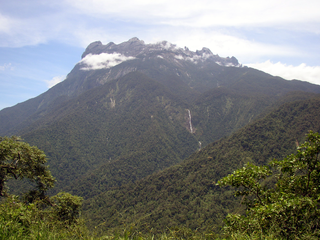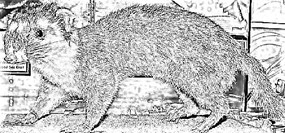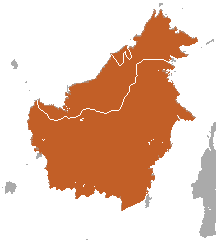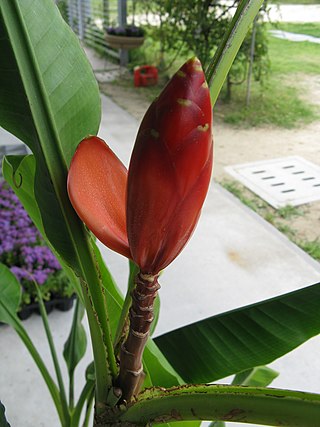
Mount Kinabalu is the highest mountain in Borneo and Malaysia. With an elevation of 4,095 metres (13,435 ft), it is third-highest peak of an island on Earth, and 20th most prominent mountain in the world. The mountain is located in Ranau district, West Coast Division of Sabah, Malaysia. It is protected as Kinabalu Park, a World Heritage Site.

Kota Kinabalu, colloquially referred to as KK, is the state capital of Sabah, Malaysia. It is also the capital of the Kota Kinabalu District as well as the West Coast Division of Sabah. The city is located on the northwest coast of Borneo facing the South China Sea. The Tunku Abdul Rahman National Park lies to its west and Mount Kinabalu, which gave the city its name, is located to its east. Kota Kinabalu has a population of 452,058 according to the 2010 census; when the adjacent Penampang and Putatan districts are included, the metro area has a combined population of 628,725. The 2020 Census revealed an increase in the municipal population to 500,421, while the wider area including the Penampang and Putatan districts had a population of 731,406.

Anomochilus is a genus of snakes, it is the only genus in the monogeneric family Anomochilidae and has three species classified within it. Members of the genus are known as anomochilids, or by the common names dwarf pipesnake, lesser pipesnake, and giant blind snake. Initially created as Anomalochilus in 1890 for the species A. weberi, the genus was renamed in 1901 because the original name was already in use for a genus of beetles. Dwarf pipesnakes are small and cylindrical, with short, conical tails and small, rounded heads that are continuous with the neck. They have blackish to purplish-brown uppersides and dark brown or black undersides, with orange-red bands around the tail and a variety of pale markings on the snout and belly. All three species of dwarf pipesnake are endemic to Sundaland, where they are found on the Malay Peninsula and the islands of Sumatra and Borneo.

Kudat is the capital of the Kudat District in the Kudat Division of Sabah, Malaysia. Its population was estimated to be around 29,025 in 2010. It is located on the Kudat Peninsula, about 190 kilometres (120 mi) north of Kota Kinabalu, the state capital, and is near the northernmost point of Borneo. It is the largest town in the heartland of the Rungus people which is a sub-ethnic group of the majority Kadazan-Dusun race and is therefore a major centre of Rungus culture. It is also notable for being one of the first parts of Sabah to be settled by Chinese Malaysians, particularly from the Hakka dialect group. It is the Northernmost Malaysian city.

Kinabalu Park, established as one of the first national parks of Malaysia in 1964, is Malaysia's first World Heritage Site designated by UNESCO in December 2000 for its "outstanding universal values" and the role as one of the most important biological sites in the world with more than 4,500 species of flora and fauna, including 326 bird and around 100 mammal species, and over 110 land snail species.

Musa is one of three genera in the family Musaceae. The genus includes 83 species of flowering plants producing edible bananas and plantains. Though they grow as high as trees, banana and plantain plants are not woody and their apparent "stem" is made up of the bases of the huge leaf stalks. Thus, they are technically gigantic herbaceous plants. Musa species are used as food plants by the larvae of some Lepidoptera species, including the giant leopard moth and other Hypercompe species, including H. albescens, H. eridanus, and H. icasia.

The Bornean ferret badger, also known as Everett's ferret badger or the Kinabalu ferret badger, is a small, nocturnal and omnivorous mammal that is endemic to the island of Borneo. It is a member of the family Mustelidae and is one of six species of the genus Melogale. It is listed as endangered on the IUCN Red List of Threatened Species due to its small distribution range, which includes Kinabalu National Park and Crocker Range National Park.

Hose's palm civet, also known as Hose's civet, is a viverrid species endemic to the island of Borneo. It is listed on the IUCN Red List as Vulnerable because of an ongoing population decline, estimated to be more than 30% over the last three generations and suspected to be more than 30% in the next three generations due to declines in population inferred from habitat destruction and degradation.

The black shrew is a white-toothed shrew only known from Mount Kinabalu in the Malaysian state of Sabah on the island of Borneo.

Mount Tambuyukon or Tamboyukon is a mountain located at the West Coast Division of Sabah, Malaysia. It is considered the third-highest mountain in the country with height at 2,579 metres (8,461 ft), lying north of the highest Mount Kinabalu.
The plant species Musa ingens, also known as the giant highland banana or Oem, is the physically largest member of the family Musaceae and the only member of the section Ingentimusa. Growing in the tropical montane forests of New Guinea - Arfak Mountains Regency in Indonesia, its leaves can reach a length of 5 meters and a width of 1 m. This, the largest herbaceous plant on earth, was completely unknown to science prior to 1960.

Datuk Seri Panglima Mohd Shafie bin Apdal is a Malaysian politician who has served as the Member of Parliament (MP) for Semporna since April 1995, State Leader of the Opposition of Sabah since September 2020 and Member of the Sabah State Legislative Assembly (MLA) for Senallang since May 2018. He served as the 15th Chief Minister and the State Minister of Finance of Sabah from May 2018 to September 2020, Minister of Rural and Regional Development from April 2009 to July 2015 and Vice-President of the United Malays National Organisation (UMNO), a component party of the ruling Barisan Nasional (BN) coalition. He has served as the 1st and founding President of Heritage Party (WARISAN) since October 2016. He lost the power as Chief Minister of Sabah following the defeat of his coalition WARISAN + in the 2020 state election.

Musa Bin Haji Aman is a Malaysian politician who served as the 14th Chief Minister, State Minister of Finance from March 2003 to May 2018, Member of the Sabah State Legislative Assembly (MLA) for Sungai Sibuga from February 1994 to September 2020, the former State Chairman of Barisan Nasional (BN) and United Malays National Organisation (UMNO) of Sabah. In April 2023, He become the direct member of Gabungan Rakyat Sabah (GRS). He is the longest-serving Chief Minister of Sabah by holding the position for 15 years and is the older half brother of Anifah Aman, the Special Advisor to the Chief Minister of Sabah on International Relations and Foreign Investments, President of Love Sabah Party (PCS) and former Minister of Foreign Affairs.

The greater nectar bat or greater dawn bat is a species of megabat within the genus Eonycteris. It is found in Brunei, Indonesia, Malaysia, and the Philippines. Its range is limited and includes Luzon to Maripipi in the Philippines and scattered parts of Borneo including Tuaran and Ranau in Sabah; Bau, Kuching and Bintulu in Sarawak.
Musa maclayi is a species of seeded banana native to Papua New Guinea and the Solomon Islands. It is placed in section Callimusa. It is regarded as one of the progenitors of the Fe'i banana cultivars.

The Kinabalu shrew is a species in the family Soricidae. It is endemic to the mountain Mount Kinabalu on Borneo, and its sister peak, Mount Tambuyukon.

Anomochilus monticola, the Kinabalu giant blind snake, mountain pipe snake, or Mount Kinabalu dwarf pipesnake, is a species of snake in the dwarf pipesnake family Anomochilidae. It is endemic to Kinabalu Park in northern Borneo, where it inhabits montane and submontane rainforest at altitudes of 1,450–1,513 m (4,757–4,964 ft). Described by the herpetologist Indraneil Das and colleagues in 2008, the species is a stout, cylindrical snake with a small head and short, conical tail. It is the largest species in its genus, with a total length of 521 mm (20.5 in). It is mostly iridescent blue-black in color, with a deep brown belly, large pale horn-colored blotches along the underside, a chrome orange band around the tail, a pale creamy-yellow bar across the snout, and pale horn-colored speckles along its sides. It can be told apart from the other species in its genus by its large size, the absence of a stripe along its sides, and the lack of pale blotches on its back.

Musa beccarii is a species of wild banana, found in Malaysia, in Sabah. It is placed in section Callimusa.
Musa borneensis is a species of wild banana, native to the island of Borneo, in the Malaysian states of Sabah and Sarawak. It is placed in section Callimusa, having a diploid chromosome number of 2n = 20.

Tenompok Forest Reserve is a protected forest reserve in Ranau District of West Coast Division, Sabah, Malaysia. It was designated as a Class 1 Forest Reserve by the Sabah Forestry Department in 1984. Its area is 1,984 hectares (19.84 km2). A former reserve, the Kampung Bundu Tuhan Native Residence Reserve, occupied what is now the eastern portion of Tenompok. The reserve is mountainous, reaching 1,660 metres (5,450 ft) above sea level. Vegetation consists of lower montane forest and montane kerangas forest. Both share a similar species composition, although trees in montane keranga forests are smaller. The reserve's Tomis River is a tributary of the Tuaran River. The area of the reserve has never received significant logging, aside from small amount near what are now its borders. This small logging is thought to be carried out by nearby villages for local use. There is also some agricultural encroachment. The reserve lies between Kinabalu Park and Crocker Range National Park. One farmer has a house within the reserve. There are several settlements around the reserve, along with agricultural land.
















